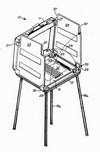 September 19, 2006 is primary day here in Massachusetts. In the recent Patently-O readership poll, 542 readers cast their vote (one per computer). Those results show that slightly over half of the voting readers work in law firms. Of those, two-fifths are in small firms. Twenty-two percent of readers hail from in-house jobs in corporate America while about fifteen percent come from academia. Government jobs only grabbed eight percent — although that category was not added until after 150 people had already voted. Thanks for participating!
September 19, 2006 is primary day here in Massachusetts. In the recent Patently-O readership poll, 542 readers cast their vote (one per computer). Those results show that slightly over half of the voting readers work in law firms. Of those, two-fifths are in small firms. Twenty-two percent of readers hail from in-house jobs in corporate America while about fifteen percent come from academia. Government jobs only grabbed eight percent — although that category was not added until after 150 people had already voted. Thanks for participating!
In a related note, Patently-O reader (and creator of ToolPat) Scott Kamholz recently did his own empirical work of blue and red states. His results:
9,060 total U.S. patents issued to U.S. assignees in August 2006. 6,635 issued to assignees in "blue" states. 2,425 issued to assignees in "red" states.
To continue reading, become a Patently-O member. Already a member? Simply log in to access the full post.